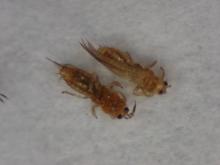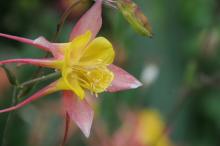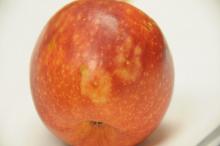Includes Frankliniella spp.
Pest description and damage Several species of thrips can cause injury to woody ornamentals. Thrips are very tiny, skinny insects, less than 0.05 inch long. Color varies from reddish-yellow to mid-dark brown. Winter populations are darker in color. Thrips have rasping mouthparts and will damage plants by sucking out the contents of plant cells and depositing tiny specks of honeydew. Damaged leaves look bleached and/or silvered and speckled with shiny "tar-spot" excreted by thrips during feeding. They can damage flower buds, open flowers, leaf buds and leaves. Damage to flowers appears as streaking in the blossoms, there may be yellow pollen on petals where thrips were feeding on the stamens. Flower life may be reduced. Damage to foliage is particularly noticeable if it occurs in the bud stage. In this case, leaves typically are distorted and may be flecked with thrips, tar-spots or feeding damage. Thrips are particularly common on gladiolas and dandelion flowers.
Biology and life history In spring, the adults fly to host plants and enter flower blossoms to feed on pollen, nectar, and flower parts. Eggs are laid in the flower parts, and the immatures emerge to feed. Several generations pass each summer, and adults may feed on adjacent flowering plants as well. Thrips also migrate into landscapes and greenhouses when adjacent infested fields are mowed.
Pest monitoring Watch for small specks of glistening frass on the surface of lilac and privet leaves; thrips look like tiny, wood slivers gliding about leaves or among blossoms. Thrips feed on pollen and may scatter pollen on petals.
Management-cultural control
Cold, wet weather during bloom reduces thrips damage. Hosing plants with water in the morning may discourage thrips.
Management-biological control
Predatory thrips species and mites can reduce populations on host plants while parasitic nematodes can kill off thrips that move to the soil to pupate.
Management-chemical control
See Table 1 in:
Chemical Control of Landscape Pests
For more information
Dreistadt, S.H., P.A. Phillips and C.A. O'Donnell. 2007. Thrips. (https://ipm.ucanr.edu/PMG/PESTNOTES/pn7429.html)




